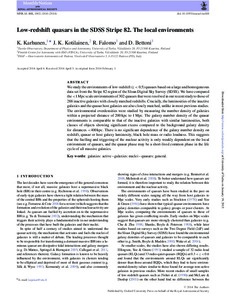Low-redshift quasars in the SDSS Stripe 82. The local environments
K. Karhunen; J.K. Kotilainen; R. Falomo; D. Bettoni
https://urn.fi/URN:NBN:fi-fe2021042714845
Tiivistelmä
We study the environments of low-redshift (z < 0.5) quasars based on a large and homogeneous data set from the Stripe 82 region of the Sloan Digital Sky Survey (SDSS). We have compared the <1 Mpc scale environments of 302 quasars that were resolved in our recent study to those of 288 inactive galaxies with closely matched redshifts. Crucially, the luminosities of the inactive galaxies and the quasar host galaxies are also closely matched, unlike in most previous studies. The environmental overdensities were studied by measuring the number density of galaxies within a projected distance of 200 kpc to 1 Mpc. The galaxy number density of the quasar environments is comparable to that of the inactive galaxies with similar luminosities, both classes of objects showing significant excess compared to the background galaxy density for distances <400 kpc. There is no significant dependence of the galaxy number density on redshift, quasar or host galaxy luminosity, black hole mass or radio loudness. This suggests that the fuelling and triggering of the nuclear activity is only weakly dependent on the local environment of quasars, and the quasar phase may be a short-lived common phase in the life cycle of all massive galaxies.
Kokoelmat
- Rinnakkaistallenteet [27094]
